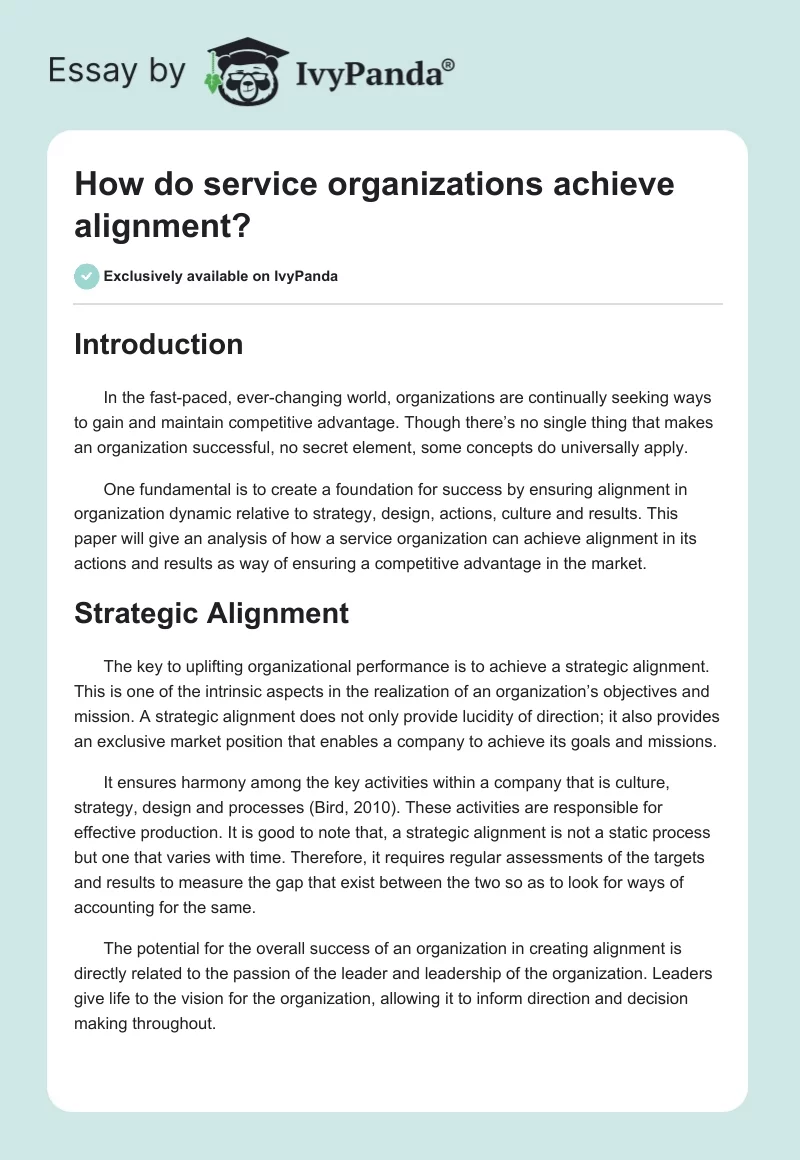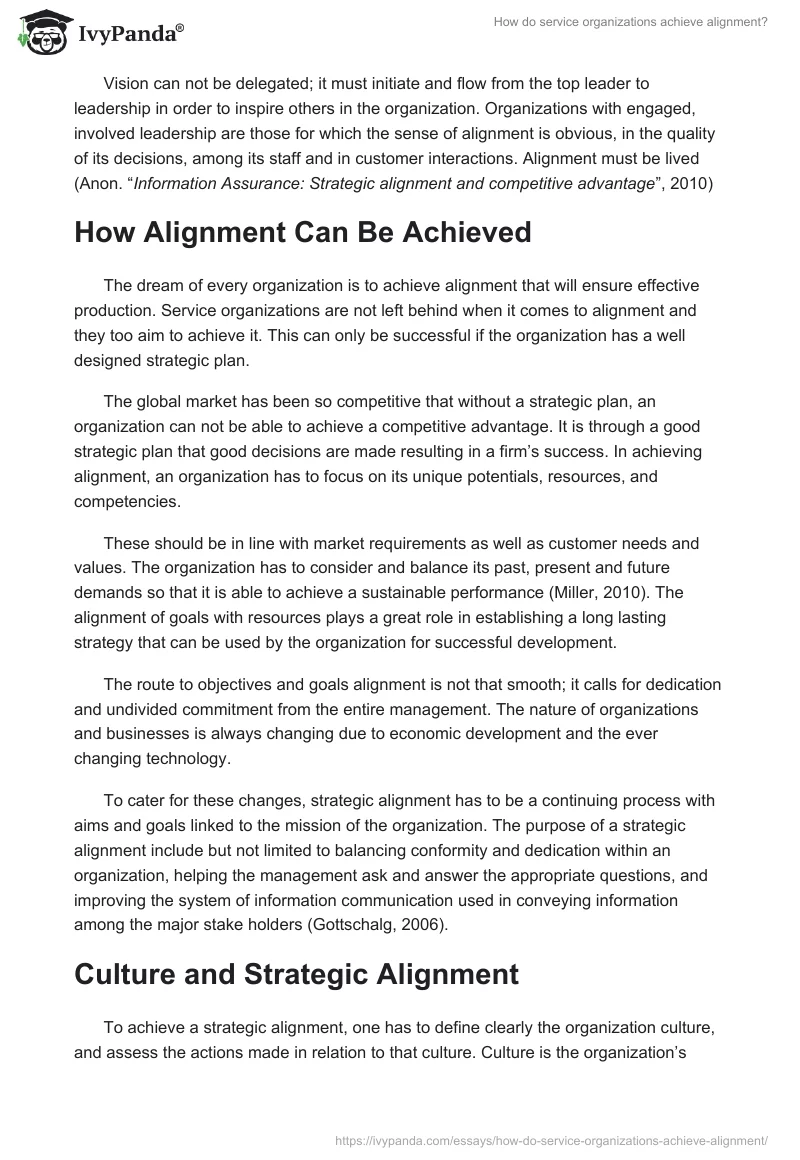Introduction
In the fast-paced, ever-changing world, organizations are continually seeking ways to gain and maintain competitive advantage. Though there’s no single thing that makes an organization successful, no secret element, some concepts do universally apply.
One fundamental is to create a foundation for success by ensuring alignment in organization dynamic relative to strategy, design, actions, culture and results. This paper will give an analysis of how a service organization can achieve alignment in its actions and results as way of ensuring a competitive advantage in the market.
Strategic Alignment
The key to uplifting organizational performance is to achieve a strategic alignment. This is one of the intrinsic aspects in the realization of an organization’s objectives and mission. A strategic alignment does not only provide lucidity of direction; it also provides an exclusive market position that enables a company to achieve its goals and missions.
It ensures harmony among the key activities within a company that is culture, strategy, design and processes (Bird, 2010). These activities are responsible for effective production. It is good to note that, a strategic alignment is not a static process but one that varies with time. Therefore, it requires regular assessments of the targets and results to measure the gap that exist between the two so as to look for ways of accounting for the same.
The potential for the overall success of an organization in creating alignment is directly related to the passion of the leader and leadership of the organization. Leaders give life to the vision for the organization, allowing it to inform direction and decision making throughout.
Vision can not be delegated; it must initiate and flow from the top leader to leadership in order to inspire others in the organization. Organizations with engaged, involved leadership are those for which the sense of alignment is obvious, in the quality of its decisions, among its staff and in customer interactions. Alignment must be lived (Anon. “Information Assurance: Strategic alignment and competitive advantage”, 2010)
How Alignment Can Be Achieved
The dream of every organization is to achieve alignment that will ensure effective production. Service organizations are not left behind when it comes to alignment and they too aim to achieve it. This can only be successful if the organization has a well designed strategic plan.
The global market has been so competitive that without a strategic plan, an organization can not be able to achieve a competitive advantage. It is through a good strategic plan that good decisions are made resulting in a firm’s success. In achieving alignment, an organization has to focus on its unique potentials, resources, and competencies.
These should be in line with market requirements as well as customer needs and values. The organization has to consider and balance its past, present and future demands so that it is able to achieve a sustainable performance (Miller, 2010). The alignment of goals with resources plays a great role in establishing a long lasting strategy that can be used by the organization for successful development.
The route to objectives and goals alignment is not that smooth; it calls for dedication and undivided commitment from the entire management. The nature of organizations and businesses is always changing due to economic development and the ever changing technology.
To cater for these changes, strategic alignment has to be a continuing process with aims and goals linked to the mission of the organization. The purpose of a strategic alignment include but not limited to balancing conformity and dedication within an organization, helping the management ask and answer the appropriate questions, and improving the system of information communication used in conveying information among the major stake holders (Gottschalg, 2006).
Culture and Strategic Alignment
To achieve a strategic alignment, one has to define clearly the organization culture, and assess the actions made in relation to that culture. Culture is the organization’s heartbeat, an expression of spirit and soul, an articulation of values. Culture reflects why and how people interact inside and outside the organization. It is the soil in which organizational behavior (group dynamic) grows or dies functions and dysfunctions (Gottschalg, 2006).
It is where commitment and investment reside. Culture is the experience. An organization culture should be designed in such a way that, it is capable of laying a strong foundation for achieving positive results. After defining the organization culture, the next step is to evaluate the actions so as to ensure that, they are in alignment with the results.
Alignment and Competitive Advantage
The alignment of goals and actions provides a competitive advantage for the organization in the global market. A competitive advantage is a unique aspect in every organization that helps it compete in the global world. An essential core competency is an organization-wide ability to effectively deal with change and to be comfortable with being uncomfortable.
Change is not an option. It exists everywhere, in every industry, every social sector initiative. When organizations build expectation around the ability to ride the waves of change into the culture, and manage that expectation, they fundamentally position themselves for success. The interaction and integration of the three critical components creating the dynamic within an organization play a critical role helping an organization achieve its competitive advantage.
When put together in a way that aligns these three components (that is strategy, design and culture), they work together as a dynamic that helps an organization gain and sustain competitive advantage. Alignment determines the organization’s potential for success in the marketplace and creates the internal environment to get it all done. As a dynamic it creates a way of working (Powell, 1992).
Strategy links to vision and strategic intent. It creates where the organization is going and defines the road it takes to get there. Clarity and agreement around what the organization is designed to do is an essential driver to success. Having a common purpose is critical. On the other hand, design involves the tangible elements organizational structure, systems, processes, practices, facilities, just to name but a few. Design creates the framework within which organizations operate. It is the framework and becomes the engine (Miller, 2010).
Conclusion
Creating organizational alignment is a journey, not a destination. As the world changes, systems for scanning, measuring and ensuring continued alignment become basic requirements. By developing, accepting and aligning, this dynamic forms the best position for an organization to create sustained excellence and success, resulting in competitive advantage.
The business world is changing drastically requiring organizations to engage in ongoing processes for alignment. One of the key factors to consider while considering strategic alignment is the organization culture. Every organization has a different culture that defines its operation. Failure to understand this culture may result in poor performance due to lack of a competitive advantage.
Reference List
Anon. (2010). Information Assurance: Strategic alignment and competitive advantage. Web.
Bird, M. (2010). Modern Management Guide to Information Technology. Create Space. Web.
Gottschalg, O. (2006). Interest alignment and competitive advantage. Web.
Miller, S. (2010). Increase competitive advantage with business process outsourcing alignment. Web.
Powell, T.C. (1992). Organizational alignment as competitive advantage. Strategic Management Journal, 13:119-134.


